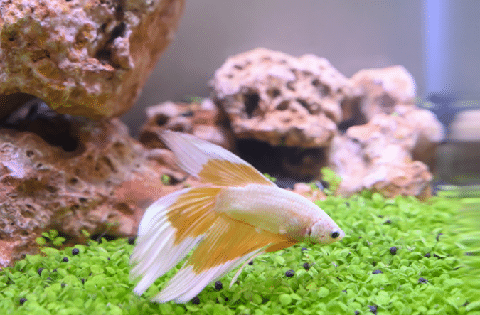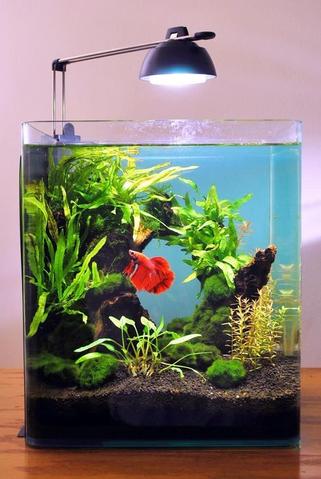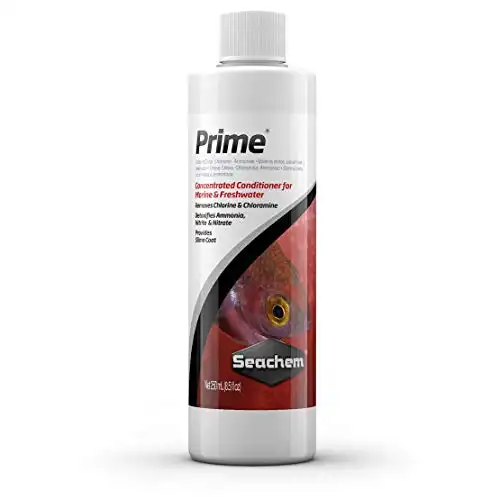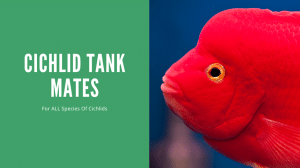Thank you for visiting! By the way… any links on this page that lead to products on Amazon and other stores/partners are affiliate links Aquarium Store Depot earns a commission if you make a purchase.
If you’re a new betta owner, you’re usually bombarded with a massive influx of information while searching for the best betta fish tank size on the Internet. And you might wonder, “What exactly is the right size for a betta fish tank?”
Unfortunately, naive pet owners keep their bettas in all bizarre things of all sizes, such as in a vase or a bowl, and pose questions to themselves, “why did their betta die?” I understand the frustration and this is why, today, I’m clearing all the misconceptions about betta fish tank size.
Stick with me to crack the code.
Betta Fish Need Room To Swim
Since betta fish originally lives in warm water rice puddles around Asia1, many people think they are fine in a vase or small tank. However, that’s not true.

Betta fish needs enough swimming space that is its own private space with lots of aquatic plants. The rice paddies in Asia might seem like little puddles but these are mostly waterlogged for miles, which allows your betta to swim freely in its own space.
The truth: Get your betta fish the largest tank possible to meet their needs. Originally, the tank size should be no less than 5 gallons for a single betta. To accommodate betta fish with other tank mates, the recommended tank size should be no less than 10 gallons.
Recommended Tank Size for a Betta Fish
In pet stores, you will find different tank sizes at different costs. However, you’ll realize that the cost of a 10-gallon tank is very reasonable as compared to a 1-gallon tank. That’s because a 10-gallon tank is the standard recommended size for a betta fish and many reliable companies produce them in bulk. Besides the cost difference between a 1-gallon tank and a 10-gallon tank is so trivial provided the amount of free-swimming space you’ll get for your betta. Therefore, I suggest investing in a betta tank of no less than 5 gallons, if you want to keep a single betta in it. Otherwise, if you plan to build a community tank, the bigger your tank, the better.
Many experienced aquarists would recommend you get a larger tank for your betta fish because no one fancies a sad betta fish in a plain water bowl with no decorations and aquarium plants in it. Bettas are territorial and they require plenty of hiding places, aquatic plants, and decorations to ensure the longevity and happiness of betta fish.
What Is The Ideal Tank?
In the pet stores, you will find all kinds of betta tanks ranging from plastic ones, gallon tanks, a tank that is curved from the front, and a 10-gallon tank. Therefore, it is baffling to choose between a myriad of options.
The ideal betta tank is the one that is feasible for your betta first, and then, the owner.
Here are the requirements for an ideal betta fish tank.
A Low Wide Tank
In their natural habitat, betta lives in shallow waters (rice paddies, particularly). The fact that bettas are surface dwellers makes it pointless to get a tank that is deeper and not wider. Your betta will not use the space at the top. Also, it makes the cleaning process difficult for you.
I recommend purchasing a wide low tank for your bettas. For example, a 10-gallon tank would be an ideal tank size in this scenario. This 13 gallon tank by current USA is a great kit to try as well.
The perfect first time aquascaper tank. Comes with dragonstone rock. Just add filtration and plants!
76° to 81°F Degree Water
Yes, betta fish prefers warm water, and anything below 76° F would pose a problem to their immune system. It also means that you should get a tank that can accommodate house a heater. Setting the heater at 80 degrees is an ideal water temperature for your betta fish.
Also, install a filter to move the water so there are no hot or cold spots.
Fog and Scratch-Free Aquarium Walls
Betta fish is a highly interactive pet that can bond with its owners, watches them, plays with them, and perform for them.
However, plastic tanks obstruct their vision to see the owners and play with them. Therefore, I always recommend choosing glass or acrylic aquariums rather than plastic. Glass or acrylic materials do not fog up or scratch over time.
Tips For Buying The Tank And Other Accessories
Now that we know the right tank size for a single betta fish is at least 5 gallons, and for betta fish with tank mates, the recommended size is 10 gallons.
Here are some tips that will cut your tank shopping time in half.
Tank size
As mentioned above, if you’re planning to keep a single betta fish, the bare minimum tank size is a 5-gallon tank. However, if you plan to keep tank mates with your betta, the recommended size is a 10-gallon tank. And if you’re considering more than one betta fish. For example, 5 female betta fish, the recommended aquarium size should be 30 gallons.
Location of the aquarium
The location of the aquarium matters: even if you get the ideal tank size, the location can mess everything up. Since betta fish are a tropical fish, many aquarists prefer placing the tank in an area with direct sunlight to keep the water temperature high. However, this practice can be detrimental to your fish.
Betta fish do not enjoy their tanks placed in an open area where direct sunlight could reach them all day. Direct sun can result in an abnormal rise in the temperature, which is unhealthy for your betta fish. As a result, the fish either stop swimming or swim in crazy patterns. I recommend placing your betta tank on the inside wall, enabling only indirect sunlight to reach the tank.
Also, avoid placing your betta tank opposite mirrors. Male betta fish is territorial and can get pretty aggressive when introduced to other fish. Therefore, placing your tank against the mirror will allow your male betta fish to think he has another competitor in the tank and will try to constantly attack the other fish. Eventually, he will stress out and die of exhaustion.
Instead, I suggest putting a magazine cover with flowers, floras, and reefs on the back of the aquarium to give him colorful vibes.
Travel Tanks
If you’re a betta connoisseur and a travel enthusiast who often travels in a car, truck, or RV, I suggest getting plastic aquarium tanks. There are travel-friendly aquarium tanks of all sizes in pet stores. However, if you’re investing in a small tank, don’t keep more than one betta fish tank size in a tank.
Tank Toys
Betta fish are one of the most active fish I came across, so, it would be a sad thing to watch them in a boring, dull tank with just water. To keep your betta happy and healthy, I suggest adding some tank toys to the aquarium. A few river rocks placed above each other can make an excellent hiding place. Besides, colorful gravel on the bottom will add more stimulation and life to your tank.
Water Conditioner
Betta, like most fish, is vulnerable to harmful chemicals and toxins, such as Chlorine, Ammonia, and Chloramines. Therefore, it is advisable to neutralize the tap water before adding the fish.
Here’s how to do it step-by-step:
- Fill a water container and leave it overnight
- Add a good quality water conditioner before adding it to the tank
- Add the water to your tank and introduce your betta fish into it
Seachem prime is a easy to use and affordable choice when it comes to remove chlorine and chloramines from your tap water. Highly recommended!
Tank Setup
There’s a lot more to the beta tank setup than just size. However, when it comes to betta fish, size matters. Since betta has an organ named labyrinth, which allows your fish to breathe like humans, surviving outside of water for a few minutes, many novice aquarists believe betta can live in a small tank. However, it’s not true.

Betta fish tank size should be no less than a 5-gallon tank. Anything smaller than a 5-gallon tank is detrimental to their health and wellbeing. However, if there are some emergency reasons you cannot provide even a 5-gallon tank, you should invest your time in changing the water of your betta’s tank regularly, if you want their long, flowy wings to remain vibrant and beautiful.
Filtration
I don’t recommend filtration for bettas living below a 5-gallon tank, but water changes on a regular basis are crucial for those living in a smaller tank. If you have a tank size of around 5 gallons or more, then filtration is important.
Therefore, I recommend getting a reliable water treatment kit or an aquarium test kit from pet stores. Follow the directions mentioned on the kit and get the tank water ready for your bettas.
Experts recommend letting the water sit for around 48 hours. It allows the chemicals to affect the water, starting with the nitrates to offer the best environment for a happy life for your betta fish.
I also advise investing in a filtration system that has a multi-stage filtration system that allows the good bacteria to live freely and keep the water quality optimal.
Heater
Since betta fish are tropical fish, they hardly need chillers, however, heaters are imperative to their physical and mental health.
As mentioned above, the ideal water temperature for betta fish is around 76° to 81 °F. Thus, if you’re getting a tank smaller than 5 gallons, I advise investing in a small heater as a regular-sized heater would be too much to handle. I recommend getting a 3 or 5 watts per gallon heater for a betta tank that maintains the water temperature at the proper parameter. Additionally, you can get a temperature gauge to monitor your temperature.
Frequent Water Changes
You should change your betta’s tank water regularly to maintain the quality. Changing the water frequently results in a happy, healthy, and thriving betta fish. Also, it protects your betta fish from potential diseases.
Here’s how you frequently should you change the tank water, depending upon the size.
- If the tank is below 2.5 gallons, change the water every 2 to 3 days. (100% water change)
- If the tank size is around 2.5 gallons to 5 gallons, change the water every 3 to 5 days. (50% water change)
- If it is a 5-gallon tank and above, change your tank water twice a month with a 25% water change once a week
Aeration
For bettas, aeration is the most important thing to do. No matter how large your tank is and how great your filtration system is, aeration is still a major factor in the well-being of your betta. Many aquarists go with an airstone and connect it to their air pump. It allows a cloud of bubbles that makes your betta tank much wholesome and betta loves these bubbles as well.
However, make sure that the aeration in your tank is not overpowering because betta fish lives in stagnant waters, in their natural habitat. Thus, don’t forget to be gentle.
To manage the water flow, I suggest placing your driftwood, aquatic plants, and other tank ornaments in the direction of the pump to weaken the flow and protect your betta fish.
Accessories
I don’t recommend adding accessories to the tank if your betta’s tank mates are fish with long and flowy fins. For example, half moons and crown tails. But many people prefer live or plastic plants. If you opt for these decors, make sure you don’t get the ones with sharp or pointed edges, harming your betta’s fins.
If you have small tanks, I don’t recommend any substrate, decors, or plants. That’s because it makes the cleaning process tedious.
Substrate
If you think substrate is not important, think again.
Substrate allows good bacteria to host in your tank. These good bacteria eat the harmful comes and keep ammonia development at bay. For adding substrate to your betta tank, I suggest getting medium size gravel. I don’t recommend adding sand, even though it looks beautiful, it’s harder to clean and a budding ground for algae.
Aquatic Plants
Most people think betta plant selection is easy as a breeze. You choose a plant, take it home, and place it in the tank. But that’s not how easy it is.
For betta fish, choosing the right plant can do wonders. Firstly, the right plants produce a perfectly healthy life for your betta. Secondly, it provides you with some visual satisfaction. Therefore, I’m listing some great plant options for your betta fish tank.
Plastic or Natural Plants
You can choose plastic or live plants for your tank. However, there are downsides and upsides to both types. The first advantage of plastic plants is they don’t die or dirty up your water. But the disadvantage is that they don’t produce oxygen for your tank.
On the contrary, natural produce oxygen for your tank, but they die and need to be replaced. The other problem with live plants is it makes your water very hard to clean.
Some ideas for live plants for your tank
If you want plastic plants, you can get all the colors, sizes, and shapes you want. Until and unless they are not pointed or sharp, they are fine for your tank.
However, the live plants that are ideal for your betta include water Lillies and other floating plants. Floating plants are good for your betta tank as they provide a natural cover for your fish. Also, male bettas can create their bubble nest in the floating plants easily.
Water wisteria is another great option for your betta tank. Water wisteria has round leaves, which helps your betta to sit on their underwater leaves. I also suggest adding plants with a large foilage underwater to help bettas hide and play. Also, Java fern and pothos make an excellent choice of plants for the betta tank.
Maintenance Guide
Betta fish are considered very hardy and easy to look after. However, they will fall ill and inactive if the proper requirements are not met. In this section, I’ll discuss some important tank maintenance tips to give your betta fish a happy and healthy life.
Daily Tank Maintenance
- Make it your habit to inspect the tank water and fish regularly. Any signs of illness or stress should be administered immediately. The earlier you’ll rule out any problems, the better.
- Look out for cloudy water or a foul, unusual smell. If this happens, check your filtration system and assess the water flow through your filter system. Most probably, you’ll need to change the water if this happens.
- Invest in a tank thermometer, and monitor the temperature daily. Make sure the water remains at the ideal temperature for your betta. If it fluctuates, adjust the heating system.
- Keep an eye on the food you feed. Do not overfeed your betta fish. Remove any uneaten food from the tank to avoid water fouling. Make sure your betta is eating properly. If not, quarantine the fish as it suggests signs of illness or stress in the fish.
Weekly Tank Maintenance
- Change the water weekly to maintain water quality. The best way to do this is to remove around 20% of water and replace it with already conditioned water at the same water temperature as the betta tank.
- When you change the water, don’t forget to clean the substrate. Use a siphon to clean the underlayer and clean the debris. Scrape the aquarium from the inside and clean it from outside the tank. Check the lighting and filtration system, and adjust the temperature.
Monthly Tank Maintenance
- Clean the tank using lukewarm water thoroughly. Rinse the decorations in hot water and sanitize them with aquarium-safe sanitizers.
- Maintain the filter system and rinse it well. Avoid touching or cleaning the biological filter to maintain the beneficial bacteria in your tank.
FAQs
Is 1 gallon enough?
A 1-gallon tank is certainly not enough for a betta. But better than the small container, or cups, or a washing machine, or a lemonade glass, or any other bizarre place where bettas are usually kept in fish stores.
Is 2 gallons enough?
Betta fish can survive in a 2-gallon tank. However, if you want to keep it happy, a 2-gallon tank is not enough. If you’re keeping fish in a 2-gallon tank, make sure to change the water daily 100%, and the lights should be low.
Can they fish live in a 2-gallon tank?
However, not recommended, betta fish can live in a 2-gallon tank, provided that you change the water 100% daily and clean the tank thoroughly.
Is a 20-gallon tank too big?
No. No tank is too big for your betta. A 20-gallon tank laden with rocks, driftwood, aquatic plants, heater, and filtration system is a dream home for your betta. Besides, if you’re planning to add tank mates, a 20-gallon tank is a great size to start.
Do they like large tanks?
Yes, betta fish loves and thrives in a large tank. A betta will get seriously stressed when placed in a small tank (smaller than 5 gallons). Therefore, it is recommended to keep your betta fish tanks larger and provide them with enough space to avoid potential health issues and stressful behavior in your fish.
Will they be happy in a 5-gallon tank?
Yes, a single betta fish will be very happy in a 5-gallon tank.
Final Thoughts
Betta fish is a beautiful creation that adds an extra oomph to your home aquariums. However, providing them with the right tank size and optimal tank setup is your responsibility as an owner. If you’re confused, let me break it down for you: for a single betta fish, we recommend a tank of no less than 5 gallons. And for a community aquarium, the recommended tank size is 10 gallons. Furthermore, no matter how big your tank is, you should avoid putting two male bettas in a single tank.
- About the Author
- Latest Posts
I’m thrilled that you found Aquarium Store Depot! Here you’ll find information on fish, aquariums, and all things aquatics related. I’m a hobbyist (being doing this since I was 11) and here to help other hobbyists thrive with their aquariums! I adhere to a high quality Editorial Process and Review products with real life field usage and practical analysis.







